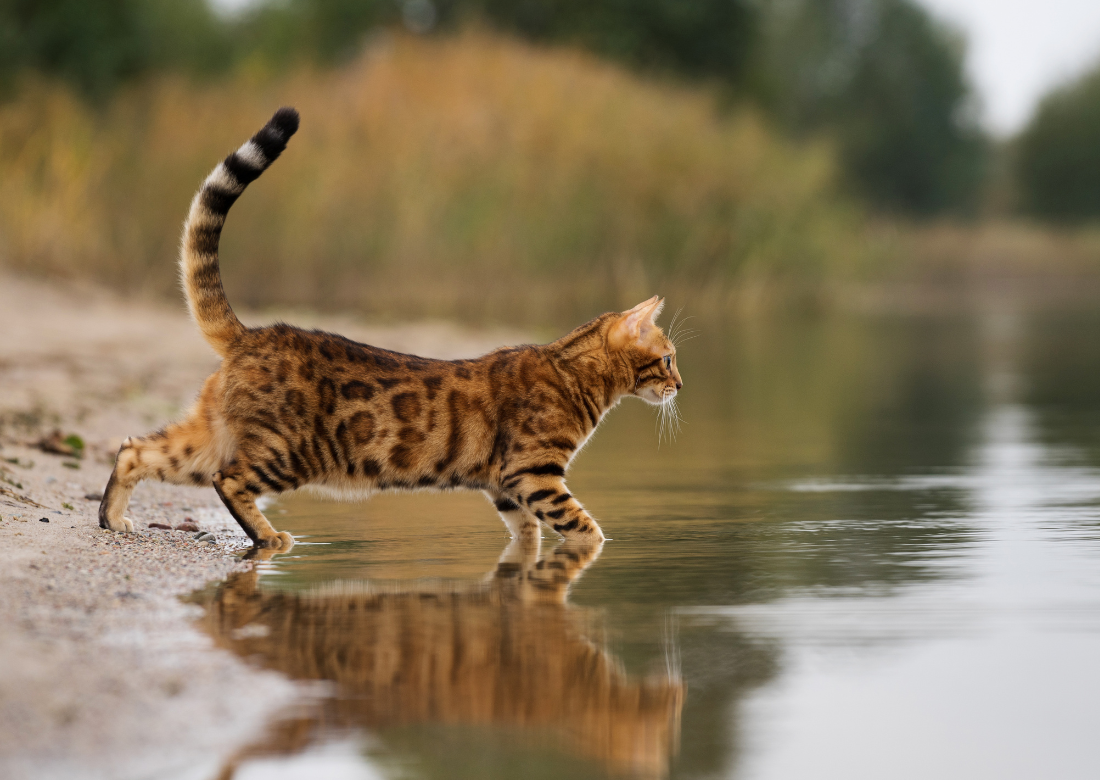The Truth About Cats and Water

Some like playing with it, a few breeds are known to love it, but in general, cats dislike water. Being meticulous groomers, their coats are designed to repel water, not to become saturated. But what happens when they become stuck in the mud, literally? Let’s find out the truth about cats and water.
Water Cat Breeds
Most domestic cats are known for their aversion to water, but there are breeds that generally exhibit a greater tolerance to, or even a fondness for, water. Individual preferences vary, and not all cats of a particular breed are the same. But in general, these breeds are recognised as more water friendly.
- Turkish Van: This breed is often referred to as the “swimming cat.” Turkish Vans have a water-resistant coat and are known to enjoy playing in water.
- Turkish Angora: Like the Turkish Van, the Turkish Angora may have a propensity for water and may not be as averse to getting wet as other breeds.
- Siberian Cat: This breed loves to play with water, and some even enjoy standing in their water bowl.
- Maine Coon: Some Maine Coon cats are curious about water and might tolerate it better than other breeds.
- Bengal: Bengal cats are distant relatives of the Asian leopard, and as such are comfortable around water.
The generalisation that cats dislike water holds true for many, but there are always individual variations in behaviour. Personality plays a significant role, and some domestic cats may be more tolerant of water than others, while some in the above water-loving breeds may detest it.
Cat Coat
Cat coats vary in thickness, length, texture, colour and the number of layers. Much like our hair, the feel of cat fur is a reflection of genetics, age and overall health.
Cat coats can have single, double or triple layers. Coats with double or triple layers have an undercoat; a soft, downy layer of fur beneath their outer coats. All cats, even the Sphynx breed, shed, but at degrees that vary greatly. Shedding is also a factor of seasonal changes.
Cats are notorious groomers. Their tongues have a covering of papillae, which act as a brush to comb their coats.
Grooming helps remove loose fur, distribute natural oils, and keep the coat in good condition. Brushing your cat helps minimise the amount of fur they ingest, in turn minimising furballs. Regular brushing in double or triple layer cats with medium to long hair also prevents matting. Discover your cat’s coat type and grooming needs to help them maintain their coat.

Stuck in the Mud
Curiosity may lead a cat of any age into trouble. Bathing your cat may be a necessity at some stage, and it is a challenging task. Before plunging into a full bathing ritual, you must first assess whether your cat will even tolerate a bath. Out of mortal fear, a cat in a state of panic can cause serious damage.
A quiet, calm environment is a must. Gather your supplies; the shampoo you use should be safe for cats and fragrance free. You’ll need plenty of clean, dry towels, a jug and, if you can find one, a confident helper.
The laundry sink or a good size tub on a countertop is ideal. Fill the sink or tub with lukewarm water just deep enough to submerge about half their legs. Now for the tricky part. Assess your cat.
With a firm hold of your cat, place them gently in the water. If your cat loses its cool, try supporting them behind their front legs with one hand, the other holding or stroking their back. Do not try “scruffing”, which involves a firm, pulling action, which causes pain and anxiety. If your cat lashes out and is obviously stressed, admit defeat and call your vet to do the job.
If your cat is tolerant of the bath, your helper can then follow on with washing their coat. Use minimal shampoo and be sure to rinse thoroughly. Any fragrance in their fur will stress them. Left-over soap can irritate their skin and be ingested during grooming.
Once they are rinsed clean, wrap them in a towel. Give lots of gentle, soothing praise. Using a hairdryer is pushing your luck. Keep your clean cat in a warm room, changing to dry towels when necessary. Offer treats at this stage, the reaction to which will let you know how their stress levels are going. Brush them when their fur is dry enough.
Hydration
If there’s an area where cats need more water, it’s inside their bodies. Cats, particularly if fed an exclusively dry diet, are prone to kidney issues as a result of chronic dehydration.
Cats aren’t natural water drinkers. Being obligate carnivores, they thrive on a diet consisting of animal meat and fats. A cat’s style of play demonstrates their innate hunting instinct. Their eyes, ears, whiskers and flexibility are all designed to bring success. As such, they would naturally derive all the hydration they need through consuming fresh prey.
But in domestic life, we feed them a civilised meal in a bowl. Fresh and canned food should offer an adequate amount of water to satisfy their needs. Sodium causes dehydration in cats as well as us, so look out for foods containing palatants with excessive sodium.
Though all cats should have a water bowl, in the case of those that eat dry food, it is imperative they have access to fresh water at all times. It may not come naturally for them to drink water from a bowl, but when they are thirsty enough, they will drink. Read more in Keeping Your Cat Hydrated.
All cats need water in their diet, especially those on dry food. Some cats enjoy playing with a dribbling tap, but their coats aren’t designed to become saturated. There are some breeds that love water, and will even take a swim, but this is a rarity and something to behold. This is the truth about cats and water.


